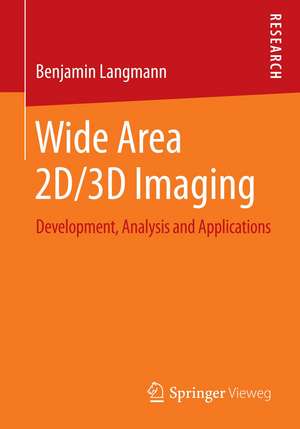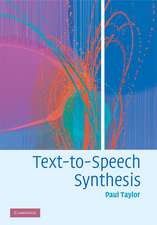Wide Area 2D/3D Imaging: Development, Analysis and Applications
Autor Benjamin Langmannen Limba Engleză Paperback – 14 iul 2014
Preț: 324.82 lei
Preț vechi: 406.02 lei
-20% Nou
Puncte Express: 487
Preț estimativ în valută:
62.15€ • 65.07$ • 51.43£
62.15€ • 65.07$ • 51.43£
Carte tipărită la comandă
Livrare economică 07-21 aprilie
Preluare comenzi: 021 569.72.76
Specificații
ISBN-13: 9783658064563
ISBN-10: 3658064560
Pagini: 150
Ilustrații: XIV, 136 p. 71 illus.
Dimensiuni: 148 x 210 x 12 mm
Greutate: 0.21 kg
Ediția:2014
Editura: Springer Fachmedien Wiesbaden
Colecția Springer Vieweg
Locul publicării:Wiesbaden, Germany
ISBN-10: 3658064560
Pagini: 150
Ilustrații: XIV, 136 p. 71 illus.
Dimensiuni: 148 x 210 x 12 mm
Greutate: 0.21 kg
Ediția:2014
Editura: Springer Fachmedien Wiesbaden
Colecția Springer Vieweg
Locul publicării:Wiesbaden, Germany
Public țintă
ResearchCuprins
Introduction.- Depth Camera Assessment.- PMD Imaging.- Calibration of Depth Cameras.- Multi-Modal Background Subtraction.- Super-Resolution for Depth Maps.- Multiple Camera 2D/3D Tracking.- Conclusion.
Notă biografică
Benjamin Langmann studied computer science and mathematics at the Technical University of Braunschweig, received a doctorate degree from the University of Siegen and leads now the research group “Industrial and Medical Imaging” at the Institute for Measurement and Automatic Control of the Leibniz University Hannover, Germany.
Textul de pe ultima copertă
Imaging technology is an important research area and it is widely utilized in a growing number of disciplines ranging from gaming, robotics and automation to medicine. In the last decade 3D imaging became popular mainly driven by the introduction of novel 3D cameras and measuring devices. These cameras are usually limited to indoor scenes with relatively low distances. Benjamin Langmann introduces medium and long-range 2D/3D cameras to overcome these limitations. He reports measurement results for these devices and studies their characteristic behavior. In order to facilitate the application of these cameras, common algorithms are adapted to the 2D/3D data and new approaches for standard computer vision tasks are introduced.
Contents
Benjamin Langmann studied computer science and mathematics at the Technical University of Braunschweig, received a doctorate degree from the University of Siegen and leads now the research group “Industrial and Medical Imaging” at the Institute for Measurement and Automatic Control of the Leibniz UniversityHannover, Germany.
Contents
- Long-Range 2D/3D Imaging
- Fundamentals of Time-of-Flight Cameras
- 2D/3D Camera Calibration
- Background Subtraction, Segmentation and Tracking
- Graduate students and scientists of computer sciences and engineering
- Engineers in research and development of safety engineering and automation technology
Benjamin Langmann studied computer science and mathematics at the Technical University of Braunschweig, received a doctorate degree from the University of Siegen and leads now the research group “Industrial and Medical Imaging” at the Institute for Measurement and Automatic Control of the Leibniz UniversityHannover, Germany.
Caracteristici
Publication in the field of technical sciences Includes supplementary material: sn.pub/extras












